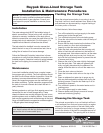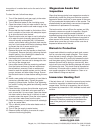
Raypak, Inc., 2151 Eastman Avenue, Oxnard, CA 93030 (805) 278-5300 Fax (805) 278-5468
Litho in U.S.A.
tom portion of a vertical tank and on the end of a hori-
zontal tank.
To clean the tank, follow these steps:
1. Turn off the electricity and gas supply to the water
heater piped to the storage tank.
2. Turn off electrical power to the circulating pump.
3. Close the valves on the hot water outlet on the top
of the storage tank and the cold water supply to the
system.
4. Ensure that the drain located on the bottom of the
tank is routed to a floor drain with adequate capac-
ity to allow the tank to be drained.
5. Open the drain valve and open a vent to allow the
air to enter the tank (manually opening the relief
valve will usually accomplish this). Use extreme
caution, as the water exiting the tank drain may be
very hot. Avoid contact with the hot discharge water
to prevent the risk of severe scald injury.
6. Allow the tank to drain completely.
7. Remove the cover over the manway or hand hole
(if equipped). Remove the bolt(s) securing the tank
access opening. Use a flashlight to observe the
sediment collected in the tank.
8. Use hand tools to remove all sediment from the in-
terior of the tank. Use care not to damage the inte-
rior lining of the storage tank.
9. Use a water hose to flush the remaining sediment
from the interior surfaces of the tank and ensure
that all debris is removed. Scale or sediment al-
lowed to reach the potable system can foul valves,
pumps, strainers and other water fixtures. Ensure
that the tank interior is clean before refilling the ves-
sel.
10. Install a new gasket on the manway or hand hole to
prevent any possible leaks. Tighten the gasket
properly to prevent leaks. Caution: Over tightening
can result in cutting the gasket and allowing a water
leak to occur.
11. Close the drain and open the cold water supply and
hot water outlet. If the relief valve was used for a
vent, ensure that it is now closed. Open the closest
hot water valve to allow the air in the tank to vent
as water enters the vessel. Close the valve opened
for a vent when water flows from the valve.
12. Check the manway or hand hole and all related pip-
ing for any water leaks.
13. Turn on electric power to the water heater and cir-
culating pump.
14. Turn on the gas supply to water heater.
15. Observe heater and piping to ensure all compo-
nents are functioning properly.
Magnesium Anode Rod
Inspection
Glass lined storage tanks have magnesium anodes to
cathodically protect the lining and minimize corrosion.
Aggressive water conditions in some areas of the coun-
try may accelerate the deterioration of the anodes. The
anodes should be periodically removed and inspected
to determine if replacement is necessary.
The tank must be valved off from the system and fully
drained to remove an anode for inspection. Raypak
storage tanks have multiple anodes installed in
threaded tappings along the length of the tank or on top
of the tank. Adequate service clearance is required to
allow removal of an anode. The anodes should be re-
placed when more than six inches of the core wire is
exposed at either end of the rod.
Dielectric Protection
Inspect each dielectric coupling at each tank connec-
tion for corrosion and proper operation. This is done
when the tank is empty using an Ohm meter, which
must indicate there is no continuity between the tank
and the system piping. Should the electrical isolation
between the tank and its piping or structure fail, elec-
trolysis will occur and the resulting damage will eventu-
ally destroy the tank. This check must be repeated at
least every 18 months with no water in the tank to en-
sure proper operation of the dielectrics. Clean or re-
place dielectric fittings as required.
Immersion Heating Coil
If the tank has a coil, it should be removed every twelve
months for inspection to determine lime build-up on
copper tubes. If build-up is excessive, the coil should
be cleaned by immersion in 20% inhibited muriatic acid
solution.
www.raypak.com
NOTE: For the sake of convenience, it is suggested
that the Magnesium Anode Rod Inspection and the
Dielectric Protection procedure be handled at the
time of the yearly tank draining for cleaning pur-
poses.




